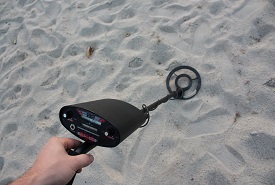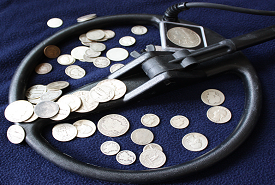Weather can be powerful and depending on where you live, rain storms, wind storms, and drought can have a huge impact on the landscape. Instead of being disappointed because you can not detect, use the weather to your advantage! Below are metal detecting tips focusing on giving you the knowledge you need to benefit from the forces of Mother Nature.
Flood/Heavy Rainfall
As with most weather, extreme is what is going to find you the long lost items that you never thought were there. While floods and heavy rainfall can cause damage they also cause erosion which can uncover new metal detecting locations. Why? Well they remove lose debris or sand and can put your detector within range of the heavy more valuable items. This can work for any body of water including lakes, rivers, streams, and even the beach. A flood can produce the same results as an extremely high tide. Look for erosion along the banks of stream/lakes/rivers etc, paying specific attention to what the ground is made up of. If you are seeing heavy rocks, shells, or other items, this is a great sign. Work the area slowly and carefully with your metal detector to try to uncover the deep items. If you are a relic hunter, keep an eye out for fossils and century old artifacts that may be unearthed. When on the beach, look for cliffs or high banks that have kept the flooding/high tide at bay, this area will be filled with items moved from the high water activity.
Drought/Low Water Levels
Conversely to the high water, metal detecting during a drought can produce quality finds as well. As the water level lowers in lakes, rivers, and streams go down to where the newly exposed bottom is and start metal detecting the area. Popular finds will be fishing related items and the occasional jewelry. Activity within the area is important, such as around boat ramps and swimming and diving areas. Similar to a drought, the beach can be filled with targets at low tide. Be sure to research when low tide is and get there about and 1 or 2 hours before so you have ample time to comb the low tide areas. This is especially true after a storm as the fluffy sand should have been removed from the area, exposing the hard packed sand.
Wind/Sand Movement
While this may sound basic, wind moves sand a great deal. Just go to the beach after a high wind, you will notice significant sand movement. This is important because it will blow away the lighter sand leaving something called “hardpan” behind. Hardpan is a combination of heavier sand usually consisting of shells and clay. This is where the goodies end up, especially the heavier jewelry, coins, and relics. Beyond the beach large wind storms can be beneficial if vegetation has been affected. Toppled trees and bush roots can be detected as well as the soil from under them. Over time the roots anchor whatever items have been dropped over time. Most likely from someone who had a picnic or was relaxing under the tree.
Manmade/Construction Crews
Remember, humans can do just as much to affect the landscape as Mother Nature. These include, tearing up existing concrete beside the road, cutting into the land for building or road construction, and foundation work or even where construction crews dump dirt. Please keep in mind you cannot just roam around construction sites, especially if there are no trespassing signs posted. Doing this at night will bring you unwanted attention from the authorities. When I hunt the sidewalk tear outs I usually do it in the morning, there are less people out but it isn’t dark as to arouse suspicion.
Good luck and be safe when using these changes in environment to your advantage!



